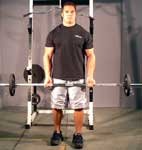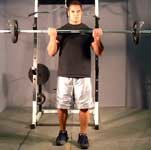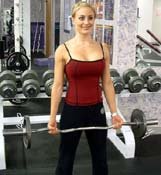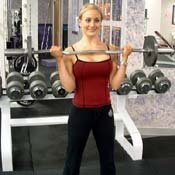| Every bodybuilder wants huge guns. Let's face it - what good is a bodybuilder with small arms? The secret to beating out the competition is on the other side of your arm. Check this out right here. |

Want to add some serious size to your arms? Big triceps are the secret!
Every bodybuilder wants huge guns. Let's face it - what good is a bodybuilder with small arms? Fielding jokes about "spaghetti arms" and "pea shooters" isn't fun. Fortunately, not many guys are opposed to training their arms, and as a result, there are a lot of pretty good sets of biceps out there.
On the flip side, though, many of these future Mr. Olympians don't have much in the way of triceps mass. Here's a little secret: The true path to giant cannons is by building your triceps. Well-developed biceps look great, but you can't walk around hitting front double bi's all day long. Triceps are what fill up shirtsleeves. Flexed or not, triceps are the ticket to looking huge, no matter what you're doing.

Triceps Anatomy
The triceps brachii has three heads: the lateral, medial, and long heads. These muscles connect the humerus and scapula to the forearm bone called the ulna. It's important to ensure you incorporate exercises that hit all three of these heads to fully develop the back of your upper arm. Simply performing one exercise for triceps probably won't be enough.
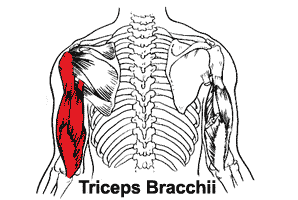
Triceps Anatomy

Training Days
In the old days of bodybuilding, they trained triceps on the same day as chest. Actually, many bodybuilders still do this. However, this old-school technique may not be the best way to go if you're looking for optimal triceps size or if your triceps are lagging.
By training tri's after chest to "finish them off," you're not using optimal weight for overloading the triceps, as they've already been partly worked as part of your chest routine. Giving your triceps your full focus by hitting them with heavier weights while they're fresh will improve your results.

The Exercises
 Close-Grip Pushdowns
Close-Grip Pushdowns
These are the same tried and tested pushdowns that bodybuilders have been doing for years. One common mistake that many trainees make is to let their elbows drift too far forward.
This stems from not controlling the weight during the negative portion of the exercise. Once this happens, the propensity for cheating by using the back muscles to help move the weight back down increases.

Close-Grip Pushdowns
So, remember to keep your elbows tucked against the torso throughout the whole exercise while controlling the weight.
 Close Grip Pushdowns
Close Grip Pushdowns | ||
| Tip: At the bottom of the exercise, push the bar towards the ground by dropping your shoulders slightly. This gives an extra squeeze on the triceps and increases peak contraction. | ||
 Close-Grip Bench Presses
Close-Grip Bench Presses
- Close-grip bench presses are a great exercise for hitting the medial and lateral heads of the triceps. This exercise can be performed in flat, incline, ordecline variations. Between 10 and 25 degrees of declination or inclination is recommended.

Close-Grip Bench Presses
Keep your elbows just short of lockout during the pressing portion of the exercise. This helps keeps tension on the triceps throughout the exercise. Also, bring the bar to the lower portion of the sternum when lowering it.
 Close-Grip Bench Presses
Close-Grip Bench Presses | ||
| Tip: Keep your hands about 13 inches apart. Bringing your hands too close together increases the strain on your elbows and wrists. | ||
 Parallel Bar Dips
Parallel Bar Dips
- Dips are one exercise that works all three heads of the triceps muscles at once. Often called the "upper body squat," dips are a must for any bodybuilding program.

Parallel Bar Dips
When performing dips aimed at triceps mass, try to remain as upright as possible. Leaning forward will incorporate the pectoral muscles more, taking some of the workload off of the triceps.
 Parallel Bar Dips
Parallel Bar Dips | ||
| Tip: When performing the negative portion of this exercise, lower your body as far as possible in between the bars. Don't stop until your biceps make contact with your forearms. This is important for getting a full stretch in your triceps. | ||
 Lying Dumbbell Triceps Extensions
Lying Dumbbell Triceps Extensions
- This exercise hits all three heads of your triceps muscle as well. You'll have to go a little lighter on this, though, in order to maintain strict form during the negative phase of the exercise.
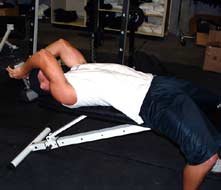
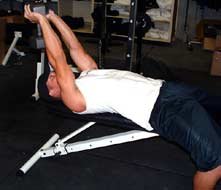
Lying Dumbbell Triceps Extensions
 Click To Enlarge.
Click To Enlarge.You can also do this exercise with one arm at a time, if you're looking for even better concentration on each muscle.
 Lying Dumbbell Triceps Extensions
Lying Dumbbell Triceps Extensions | ||
| Tip: While you're performing this exercise, remember not to turn this exercise into a lat movement. Many lifters make the mistake of trying to employ a pullover motion while extending the forearms. This is corrected by making sure your arms remain vertical, with the only movement coming at the elbow joint. | ||
 Single-Arm Reverse-Grip Pushdowns
Single-Arm Reverse-Grip Pushdowns
- Great for isolating the medial and outer heads of the triceps, single-arm reverse-grip pushdowns use the same as regular pushdowns; however, you'll be using a "palms up" grip.
 Reverse-Grip Pushdown
Reverse-Grip Pushdown | ||
| Tip: If you're pressed for time, this exercise can be performed with both hands by using a straight bar. | ||

Putting It All Together
The routine itself is set up fairly simply. Close-grip pushdowns lead off; they're a good exercise for getting the muscles warmed up.
Next comes the two heavy-hitters, close-grip bench presses and parallel bar dips. You'll be doing 8 to 10 reps for both of these with fairly heavy weight for 4 sets.
The last two exercises - lying dumbbell triceps extensions and single-arm reverse-grip pushdowns - will be done with a lighter weight.
The goal with these last 6 sets of 12 to 15 reps is to pump as much blood into the muscles as you can. We're looking at trying to improve nutrient delivery and capillary density here.
 The Routine
The Routine
| The Triceps Routine | ||||||||||||||||||||||||
|
- This workout will take place at least two days before or after your chest workout. Because traditional chest exercises like bench presses include a lot of triceps muscle recruitment, you'll want to ensure they're properly rested before you subject them to this routine.
 Nutrition
Nutrition
- Finally, do you need to be told about nutrition? It's important, guys. As awesome as it feels to manhandle the big weights, you won't build triceps that stretch out your shirts and mysteriously attract the hands of female admirers if you're not feeding your physique with the nutrients it takes to build those bad boys in the first place.
Protein... and lots of it, is extremely important. Cell-Tech Hardcore is another weapon to add to your arsenal. Everybody knows creatine works, right? Well, Cell-Tech Hardcore takes creatine supplementation to a whole new level.

